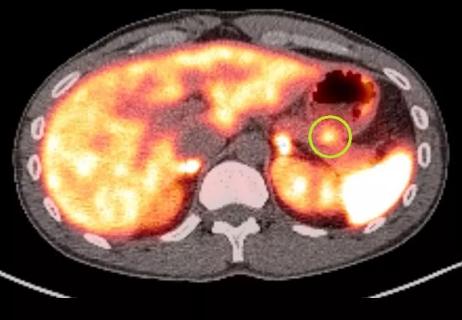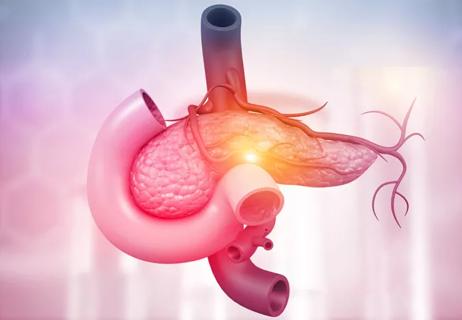Patients spent less time in the hospital and no tumors were missed

When patients present with symptoms that could indicate the presence of insulinomas — rare neuroendocrine tumors that can be benign or malignant — clinicians traditionally order a 72-hour monitored fasting test in a hospital setting. The fast ends either when the patient develops hypoglycemia, indicating an insulinoma might be present, or at 72 hours. This method, which has been used for 70 years, is highly accurate but places a considerable burden on patients and health systems.
Advertisement
Cleveland Clinic is a non-profit academic medical center. Advertising on our site helps support our mission. We do not endorse non-Cleveland Clinic products or services. Policy
Results of research by Cleveland Clinic endocrinologists suggest that an alternative, which relies on monitoring the patient’s beta-hydroxybutyrate (BHB) levels, can significantly reduce fasting time and demands on hospital resources without loss of accuracy. This has become more important because, while insulinomas are not common, the number of people presenting with related symptoms are increasing, says Pratibha Rao, MD, Medical Director of Cleveland Clinic’s Adrenal Center.
“Nowadays, with more gastric bypass surgeries happening, hypoglycemia presentations are increasing,” says Dr. Rao. “More patients with postprandial hypoglycemia are presenting after gastric bypass, either because they're developing dumping syndrome or because the insulin is still lingering around and acting much later.”
A trend analysis indicates that in 2019, more than 25,000 bypass and metabolic surgeries were performed in the U.S.— the highest year on record. While the overwhelming majority of these patients will not have insulinomas, clinicians need a test that reliably identifies those who have it and rules out those who don’t.

Insulinomas affect about four in every 1 million people. They are important to diagnose because they can release excess insulin, causing hypoglycemia that can lead to severe illness or death.
For decades, the 72-hour fasting protocol has been considered a gold standard diagnostic tool because nearly all people with insulinomas develop hypoglycemia within 72 hours of fasting. Patients fast at home for eight to 12 hours, then continue in the hospital, where they have glucose checks every four hours, then hourly when levels dip below 60 mg/dL. The fast is over when patients develop hypoglycemia (glucose less than 45 mg/dL with or without hypoglycemia symptoms or severe hypoglycemia symptoms).
Advertisement
As measured at the point of hypoglycemia, insulinoma is associated with:
An estimated 95% of patients with insulinomas will be hypoglycemic within 48 hours, but Dr. Rao says, "we at Cleveland Clinic decided not to shorten the test to 48 hours because two insulinoma patients in the standard test had developed hypoglycemia at about the 50-hour mark."
The team decided to use a biomarker that could exclude the presence of insulinoma in a patient much earlier than 72 hours. Beta-hydroxybutyrate (BHB), a ketone that provides the body with energy in the absence of glucose, stays very low in individuals with insulinoma and rises in those without it.
In June 2020, the team updated its protocol to include a blood draw every 12 hours to test for serum BHB along with prolonged fasting glucose and insulin. This new protocol allows the fast to be stopped when BHB levels climb above 2.7 mmol/L. (In a study of 21 patients with insulinoma, BHB never exceeded 0.8 mmol/L.)
In researching the new protocol, the goal was to reduce the burden on medical resources by shortening the test for healthy patients while retaining the ability to detect any insulinoma.
The research team analyzed charts for all patients who had undergone the 72-hour fasting test from 2018 through 2022. The original protocol was used for 34 patients, and the updated version with 12-hour BHB testing was used for 30 patients. Histology records were reviewed to confirm insulinoma diagnoses, and charts were checked at least one year post-test for those who had tested negative.
Advertisement
Given the reduction in the use of hospital resources and the reliability of rising BHB to exclude individuals who do not have insulinoma, Cleveland Clinic has continued to use the protocol.
“We are all really pleased with the addition of the beta-hydroxybutyrate,” says Dr. Rao. “If more sites implement our protocol and we can do a multi-center study that corroborates our findings using a similar protocol, that would be worth looking at. My hope is that we might bring the test down from 72 hours to 48 hours, but we need more research to determine that.”
Clinicians treating patients who report hypoglycemia symptoms may want to carefully consider whether a 72-hour test is needed for patients with a history of gastric bypass surgery. The timing of hypoglycemic events offers a strong clue.
“With insulinoma, patients typically experience fasting hypoglycemia, and they tend to gain weight, because there is an autonomous secretion of insulin not related to food intake,” she says. “We don't even need to subject them to the 72-hour fast, and we can do a mixed-meal tolerance test instead as a starting point.”
Advertisement
Advertisement

Results underscore complex relationship among cellular pathways in the pathogenesis of the disease

A review of current evidence and recommendations

Findings indicate clinical decision making should not be driven by initial lesion size

Patient’s unexplained low blood glucose levels in the absence of diabetes spark quest for answers

Pancreas and spleen removed to minimize risk of pancreatic cancer

Advocacy group underscores need for multidisciplinary expertise

A reconcilable divorce

A review of the latest evidence about purported side effects